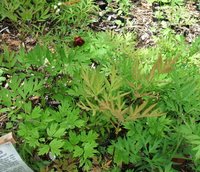Most of the tree peonies you're going to see in gardens are the large-flowered products of generations of hybridizing. But there are some strange ducks like me who like to grow the untouched wild types from which the modern hybrids have descended. In general, the species are likely to be smaller-flowered and with different foliage forms. And of course rather less colour variability.

Today's subject
Paeonia delavayi, which started to flower here on 9 June this year, is native to the mountains of western China, where it grows in open forest to grasslands, at altitudes from about a mile and a half to 2 miles. Mature size in the wild, about 5.5 ft tall by 3 ft wide.
In looking up information about this species, I found that it was only supposed to be hardy to about USDA Zone 7, so I have written in several places that I never expected it to flower but was just growing it for the foliage, which is quite remarkable-- long leafs with narrow segments and great texture. Last year, one of the several that I have potted up

surprised me with a flower, and this year two others have flowered for a total of 5 flowers this year.
The second photo is meant to show some of the different foliage forms of tree peonies. The quality isn't quite up to showing the detail I had wanted, but the narrowly-divided leaf in the foreground is
delavayi. I'll try again later.
 Rock's Peony, Paeonia rockii or Paeonia suffruticosa ssp rockii is well along at this point. No flower buds in sight yet, but this species has not yet flowered for me here (the plants are fairly young).
Rock's Peony, Paeonia rockii or Paeonia suffruticosa ssp rockii is well along at this point. No flower buds in sight yet, but this species has not yet flowered for me here (the plants are fairly young). Paeonia delavayi a few days along in the sprouting of its foliage buds, both from the root and on last year's wood.
Paeonia delavayi a few days along in the sprouting of its foliage buds, both from the root and on last year's wood. Paeonia ludlowii not as far along; most of the buds are merely swelling a bit so far but a few have begun to sprout.
Paeonia ludlowii not as far along; most of the buds are merely swelling a bit so far but a few have begun to sprout. A bit further along is Paeonia x handel-mazzettii, a natural hybrid of the previous two.
A bit further along is Paeonia x handel-mazzettii, a natural hybrid of the previous two.


